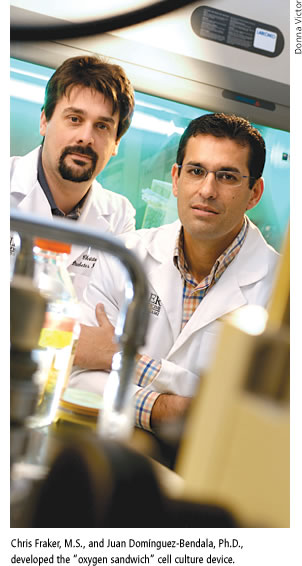 Islet cell transplantation is seen as the best hope for a cure for patients with type 1 diabetes, but there are still major challenges to overcome. One of which is the shortage of donor tissue supply since patients often need a reinfusion of islet cells after the initial treatment, and this means another donor pancreas is needed to provide the fragile islet cells for transplant. New findings by researchers at the Diabetes Research Institute at the Miller School could represent a big step forward in possibly alleviating the problem. Islet cell transplantation is seen as the best hope for a cure for patients with type 1 diabetes, but there are still major challenges to overcome. One of which is the shortage of donor tissue supply since patients often need a reinfusion of islet cells after the initial treatment, and this means another donor pancreas is needed to provide the fragile islet cells for transplant. New findings by researchers at the Diabetes Research Institute at the Miller School could represent a big step forward in possibly alleviating the problem.
Up until now, investigators have had only moderate success in differentiating either adult stem cells or embryonic stem cells to become insulin-producing beta cells. A large part of the problem has been inducing the proper culture environment in the laboratory. Researchers know that islets require a high amount of oxygen for optimal health, so UM researchers created a new cell culture device called the “oxygen sandwich” to provide the cells with a more natural oxygen environment than those used in traditional culture methods.
“Using mouse pancreatic stem cells, we were able to show that delivering oxygen in a physiological way enhanced enormously their differentiation into beta cells, with insulin levels exceeding 30-fold those observed in control conditions,” says Juan Domínguez-Bendala, Ph.D., research assistant professor of surgery, director of the Stem Cell Development and Translational Research Laboratory at the Diabetes Research Institute, and senior author of the study, which was published in Stem Cells Express.
“It is as though these stem cells were just waiting for us to provide them with the conditions they needed to mature. We believe this is a major step toward the efficient generation of beta cells for clinical transplantation.”
The new cell culture device, designed by Chris Fraker, M.S., senior research associate in the Tissue Engineering Laboratory at the Diabetes Research Institute, closely mimics the natural oxygen environment. The device “sandwiches” the stem cells with oxygen from two sources, one from the top with air diffusing through the culture medium and the second from the bottom with air diffusing through a silicon membrane mixed with perfluorocarbon, a very powerful oxygen reservoir.
“The use of high oxygen to promote differentiation of insulin-producing cells opens the way to many other applications with different sources of progenitor cells, beyond embryonic stem cells and beyond diabetes,” says Camillo Ricordi, M.D., scientific director of the Diabetes Research Institute. |


